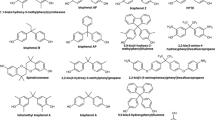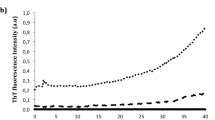Abstract
Triphenylethylene antioestrogens such as tamoxifen, nafoxidine and Ci 628 specifically inhibit oestrogen action at the target cell level1, probably by interacting with the oestrogen receptor (ER) and competitively displacing oestrogens from their binding sites. It is not clear, however, why these ligands are less biologically active than oestrogens when they bind to the ER, as no reliable difference has been found either in the binding affinity of these two series of ligands to the ER or in their ability to translocate the ER to the nucleus1,2. In fact, these antioestrogens are transformed in vivo into hydroxylated metabolites3–5 which display a better antioestrogenic activity than the injected compound and at least the same high affinity as oestradiol for the ER6. With the aim of finding an in vitro criterion to predict the agonistic or antagonistic properties of ER ligands, we have stabilized the ER in its ‘native’ or non-activated form by the use of molybdate7,8 and have compared the binding of oestradiol (E2) and of 4-hydroxytamoxifen (OHT), an active metabolite of tamoxifen, to the molybdate-treated and to the activated ER. We report here that molybdate prevented the DNA binding and the 4S to 5S transformation of the ER bound to both ligands, and that it increased the dissociation rate of oestrogens but not that of antioestrogens. Moreover, in the absence of molybdate, receptor activation by heating decreased the dissociation rate of E2 but not that of OHT. We conclude that a difference exists between the ER activation triggered by oestrogens and antioestrogens and propose that antioestrogens are acting as allosteric ligands of the ER.
This is a preview of subscription content, access via your institution
Access options
Subscribe to this journal
Receive 51 print issues and online access
$199.00 per year
only $3.90 per issue
Buy this article
- Purchase on Springer Link
- Instant access to full article PDF
Prices may be subject to local taxes which are calculated during checkout
Similar content being viewed by others
References
Clark, J. H. et al. (eds) Dahlem Konf., Life Sci. Res. Rep. 3, 147–169 (1976).
Rochefort, H., Garcia, M. & Borgna, J. L. Biochem. biophys. Res. Commun. 88, 351–357 (1979).
Katzenellenbogen, B. S., Katzenellenbogen, J. A., Ferguson, E. R. & Krauthammer, N. J. biol Chem. 253, 697–707 (1978).
Borgna, J. L. & Rochefort, H. J. biol. Chem. 256, 859–868 (1981).
Jordan, V. C., Collins, M. M., Rowsby, L. & Prestwich, G. J. Endocrinology 75, 305–357 (1979).
Borgna, J. L. & Rochefort, H. Molec. cell. Endocr. 20, 71–86 (1980).
Mauck, L. A. & Notides, A. C. 62nd A. Meet. Endocr. Soc., Abstr. 209 (1980).
Shyamala, G. & Leonard, L. J. biol. Chem. 255, 6028–6031 (1980).
Baskevitch, P. P. & Rochefort, H. Molec. cell. Endocr. 22, 195–210 (1981).
Notides, A. C. & Nielsen, S. J. J. biol. Chem. 249, 1866–1873 (1974).
Raynaud, J. P., Bouton, M. M. & Ojasoo, T. Trends pharmac, Sci. 324–327 (1980).
Weichman, B. M. & Notides, A. C. Endocrinology 106, 434–439 (1980).
Black, L. J. & Goode, R. L. Life Sci. 26, 1453–1458 (1980).
Garcia, M. & Rochefort, H. Endocrinology 104, 1797–1804 (1979).
Rochefort, H. & Capony, F. Biochem. biophys. Res. Commun. 75, 277–285 (1977).
Aranyi, P. Biochim. biophys. Acta 628, 220–227 (1980).
Sutherland, R. L., Murphy, L. C., San Foo, M., Green, M. D. & Whybourne, A. M. Nature 288, 273 (1980).
Westley, B. R. & Rochefort, H. Cell 20, 353–362 (1980).
Rochefort, H., Borgna, J. L., Coezy, E., Vignon, F. & Westley, B. in Non-Steroidal Antiestrogens (eds Sutherland, R. L. & Jordan, V. C.) (Academic, Sydney, 1980).
Lippman, M., Bolan, G. & Huff, K. Cancer Res. 36, 4595–4601 (1976).
Capony, F. & Williams, D. L. Endocrinology 19, 2219–2226 (1980).
Bullock, L. P., Bardin, C. Q. & Sherman, M. Endocrinology 103, 1768–1782 (1978).
Author information
Authors and Affiliations
Rights and permissions
About this article
Cite this article
Rochefort, H., Borgna, JL. Differences between oestrogen receptor activation by oestrogen and antioestrogen. Nature 292, 257–259 (1981). https://doi.org/10.1038/292257a0
Received:
Accepted:
Issue Date:
DOI: https://doi.org/10.1038/292257a0
This article is cited by
-
Therapeutic Potential of New 4-hydroxy-tamoxifen-Loaded pH-gradient Liposomes in a Multiple Myeloma Experimental Model
Pharmaceutical Research (2010)
-
Receptors bound to antiprogestin form abortive complexes with hormone responsive elements
Nature (1988)
-
Difference between R5020 and the antiprogestin RU486 in antiproliferative effects on human breast cancer cells
Breast Cancer Research and Treatment (1987)
-
Antiestrogen action in breast cancer cells: Modulation of proliferation and protein synthesis, and interaction with estrogen receptors and additional antiestrogen binding sites
Breast Cancer Research and Treatment (1985)
Comments
By submitting a comment you agree to abide by our Terms and Community Guidelines. If you find something abusive or that does not comply with our terms or guidelines please flag it as inappropriate.



